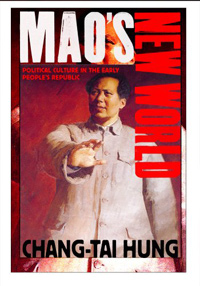Mao's New World: Political Culture in the Early People's Republic
In this sweeping portrait of the political culture of the early People’s Republic of China (PRC), Chang-tai Hung mines newly available sources to vividly reconstruct how the Chinese Communist Party (CCP) tightened its rule after taking power in 1949. With political-cultural projects such as reconstructing Tiananmen Square to celebrate the Communist Revolution; staging national parades; rewriting official histories; mounting a visual propaganda campaign, including oil paintings, cartoons, and New Year prints; and establishing a national cemetery for heroes of the Revolution, the CCP built up nationalistic fervor in the people and affirmed its legitimacy. These projects came under strong Soviet influence, but the nationalistic Chinese Communists sought an independent road of nation building; for example, they decided that the reconstructed Tiananmen Square should surpass Red Square in size and significance, against the advice of Soviet experts sent from Moscow.
Combining historical, cultural, and anthropological inquiries, Mao’s New World examines how Mao Zedong and senior Party leaders transformed the PRC into a propaganda state in the first decade of their rule (1949–1959). Using archival sources only recently made available, previously untapped government documents, visual materials, memoirs, and interviews with surviving participants in the Party’s plans, Hung argues that the exploitation of new cultural forms for political ends was one of the most significant achievements of the Chinese Communist Revolution. The book features sixty-six images of architecture, monuments, and artwork to document how the CCP invented the heroic tales of the Communist Revolution.
Reviews
“Mao’s New World offers a broad new narrative of the first decade of Communist rule, focusing on the Party’s use of culture in establishing its new political order. Chang-tai Hung provides an expansive, panoramic view of the first decade of the People’s Republic that makes clear the central place of the arts in the Party’s political strategy.”—Richard Kraus, University of Oregon, author of Pianos and Politics in China
“Mao’s New World illuminates the intertwining of art with politics, of political rule as it was expressed through culture at a moment of transformation in Chinese history. Delving into significant images and archival material, Chang-tai Hung looks at artifacts and cultural
products, such as patriotic songs, political idioms, and emotionally arousing texts. This provocative book sheds light on the way art and performance serve to motivate people through symbolic and mass communication and persuasion.”—Ban Wang, Stanford University
“Chang-tai Hung is at his very best when discussing how by building public monuments the leadership was re-creating a historical narrative that buttressed the legitimacy of Mao’s New China. He notably pays systematic attention to Soviet models in nearly every field and shows how the process of serious debate shaped planning at every stage. Soviet models and advisers were never blindly followed. There were regular interventions at the very highest political level, illustrating the high priority being given to the building of a new public culture that fit the propaganda state. Finally, by drawing on his previous work on the arts and culture of the Yan’an period, Hung in chapters on folk art points out the connections between propaganda art of the 1950s to earlier periods (especially Yan’an)
in terms of the final cultural product. Hung also contextualizes his subject in global terms by drawing parallels with the Russian and French experiences of building post-revolutionary propaganda cultures.”—Stephen MacKinnon, Arizona State University.
